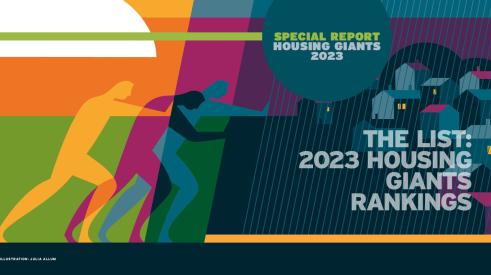When builder Mike Satterfield took a drive through his communities under construction this past March, the world looked like it had come to a halt. Instead of the usual clues indicating the normal progression of building—a poured concrete slab on lots adjacent to others with homes framed or sided or nearly completed—he saw nothing but housewrapped skeletons without windows. “Everybody is waiting on windows, and nothing is going any further,” says the EVP and CEO of Great Southern Homes, in Irmo, S.C.
Window order lead times were at least 12 weeks as of March, compared with two to three weeks before the pandemic a year ago. Satterfield makes do by “prestarting the prestart list,” ordering windows after indicating a new-home start in the company system, generating the plot plan, specifying the framing package, and securing the building permit—in other words, months ahead of time. The builder has also increased its odds of receiving what it needs by simplifying house plans to reduce the number of window sizes to just four.
Builder Tom French isn’t waiting for windows. “We’re boarding up the openings so we can continue on the inside,” says the co-owner of French Brothers, in Alamogordo, N.M. “Then we close up the windows and the exterior veneer at the end [of construction], which is completely out of sequence. But that’s what we’re having to deal with.”
And it’s not just windows. Lumber, lighting, plumbing fixtures, door and cabinet hardware, electrical circuit breakers, appliances, and just about anything imported have varying degrees of extended lead times and rising costs.
READ MORE FROM THE 2021 HOUSING GIANTS REPORT
-
Housing Giants 2021: An Unforgettable Forgettable Year: New and old challenges confronted the housing industry in 2020, and it may never be the same.
-
Home Builders Ask: Where’s the Land? You still need a checkbook, but for home builders finding and acquiring land also requires planning, perseverance, and thinking outside the box.
To cope, French Brothers is releasing all purchase orders at least 14 days before breaking ground, compared with the previous protocol of releasing them in three stages, which allowed customers to request change orders before the second release. “Now we don’t allow any change orders,” Tom French says. “Our customers are understanding. They can read the headlines and they realize if we changed something, the delivery probably will get screwed up and the house won’t be done on time.”
Home Building's Uncharted Waters
Dealing with the Great Recession and then a year of stepping around the minefields of a public health crisis was unprecedented. Never before had home builders had to navigate a market where houses are pre-selling fast while the cost of so many resources is rising and so many supplies are constrained at the same time. Under current circumstances, just-in-time purchasing models do not apply, as builders try to stay ahead of supply chain disruptions and avoid building houses without knowing how much they’ll cost at the finish line.
Soaring lumber prices have attracted much of the attention for driving up construction costs. The Random Lengths Framing Lumber Composite Price, which measures price behavior in the U.S. framing lumber market, has jumped more than 230% since March 2020 above a record $1,000 per thousand board feet in mid-February, while lumber futures for May delivery crossed $1,500.50 per thousand board feet, setting an all-time high. A 4-by-8 sheet of 7/16-inch OSB priced at $7 to $9 in February 2020 is now—depending on the supplier and region—$35 to $42.
As lumber prices climbed, the National Association of Home Builders’ estimated impact of the spike on new single-family home costs—and its effect on consumers—was often cited in media reports: by late February of this year, that cost increase stood at about $24,000 per home; by late April, it was almost $36,000, translating to about 4.7 million homebuyers priced out of the market.
One reason for the spike: Major lumber mills such as Interfor, West Fraser Timber, and Weyerhaeuser cut back production during March 2020 in anticipation of a significant long-term slowdown (if not a complete halt) in demand for lumber and panels during the pandemic. Besides, at that time their yards were stocked with product after prices for softwood lumber and panels had fallen during the previous two months. But after a relatively brief pause in March and April, housing starts surged 37.8% between May and December 2020, depleting that inventory.

Just-in-time purchasing models don’t apply, as builders try to stay ahead of supply chain disruptions and avoid building homes without knowing how much they will cost.
To be fair, lumber mills and product manufacturers are still struggling to catch up, and they intermittently find themselves dealing with staggered work schedules and reduced manpower when employees test positive for coronavirus. During a March visit to the Western Window Systems factory in Phoenix, French saw the company’s CEO and president Jeff Jackson working alongside human resources staff to load windows onto delivery trucks.
Adding to the problem: COVID-19–related slowdowns among longshoremen and truckers, which created congestion at West Coast ports and connecting rail yards that were offloading and transporting imported building products. Another punch thrown at the supply chain was the Arctic blast and power blackouts that hit Texas in February this year. That weather event took out 28% of Gulf Coast refining output, according to the U.S. Energy Information Administration, and shut down chemical plants that produce the most-used polymers for making vinyl and other plastic products.
By April, 70 chemical manufacturers had exercised force majeure (“superior force”) clauses to enable them to renege on or delay delivery contracts—three times the number issued after Hurricane Harvey in 2017. During the J.P. Morgan 2021 Industrials Conference in March, senior executives for Dow, LyondellBassell, and other chemical manufacturers warned that production capacity and inventory may not return to normal until well into the fourth quarter.
As for the downstream impact, Jon Jaffe, co-CEO and co-president at home builder Lennar, told analysts during a first-quarter earnings conference call that the storm will affect the manufacturing of OSB, insulation, refrigerators, and other products. “We’re working closely with all of these ... manufacturers to ensure that we have the products we need being delivered to our jobsites as we need them,” he said.
Managing the Building Materials Supply Chain Hurricane
While builders scale back their specs and design options to cope with delays and lack of availability across several product categories, some manufacturers are taking products off the production line. “Builders in our group are not happy about it, but we’ve got no choice,” says Bill Smithers, CEO of CBUSA, a building materials buying network of more than 500 builders in 30-plus markets.
Appliances seem to be a pinch point for everyone. Trumark Homes, a diverse home builder based in San Ramon and Newport Beach, Calif., installs a loaner stove to allow a home to close, then replaces it once the specified appliance is available. “We stopped selling washers, dryers, and refrigerators altogether,” says Rob Corbin, Trumark’s VP of operations. “We tell people they’re better off buying them on their own, but the downside is they can’t roll that cost into their mortgage.”
HOUSING GIANTS DATA
- 2021 Housing Giants List—Builder Rankings by Revenue
-
More data and 2021 Housing Giants ranking lists—home builders ranked by revenue, number of closings, housing types, and location of homes built
Other builders are taking broader steps. Taylor Morrison, based in Scottsdale, Ariz., balanced out the strong pace of fourth-quarter 2020 sales (and an even stronger January 2021) by restricting lot releases and capping sales. “I feel very good about our ability to retain the [sales and lot release] paces we saw in the back half of last year,” says chairman and CEO Sheryl Palmer, “but at the same time, I need to make sure I don’t let it get ahead of us”—and fail to properly estimate what those homes are going to cost to build.
Ashley Kent, president of Kent Homes, in Wilmington, N.C., would have liked to stop selling for a month to get a handle on costs—namely a doubling of her standard framing packages and a $750 per-house increase by her electrician to cover rising copper costs—but doing so would have sent buyers to competitors in the same master planned community.
Like many builders, Kent streamlined her purchase order process and raised sales prices—in her case, by about 9%, or approximately $20,000 on Kent Homes’ base house plan from last year. As a CBUSA member, she also benefits from a buying commitment that locks in pricing for several months. “At least I know what my price will be through June on OSB and 2-by-4s, as opposed to it changing every couple of weeks,” she says.
The NAHB estimates that for every $1,000 in additional costs to build, 130,000 homebuyers are priced out of the market.
A $20,000 increase in the framing package for an entry-level home can knock those buyers out of the market. But for now, there is more price elasticity in move-up homes, whether for straight price increases or escalation clauses in sales contracts, to help offset rising construction costs and preserve profit margins.
“You can only secure pricing [for materials] for a short period of time, so we keep building in increases with buyers,” says Jeff Benach, principal at Chicago-based Lexington Homes. “I have to stay ahead of my costs.”
Creative Strategies for Purchasing and Supply
While most builders have little influence on purchasing terms and have seen price guarantees shrink from 90 to 60 to 30 and even fewer days, there are other ways to regain some kind of a hold on the reins.
French Brothers still guarantees pricing and the closing date once buyers complete their design selections, but the builder’s construction cycle has ballooned by 20% due to supply chain issues. So it is making up other time (and reducing other costs) by focusing on callbacks and rework. A quality assurance team walks each home at three construction milestones to flag items that were missed or that need correction ... and halts work until they are addressed.
“Getting it built right the first time is the biggest thing we can do to improve our schedules,” French says. “There’s not much you can do about a supplier that says your plumbing fixtures didn’t come in this week.”
Developing process is another way to gain a measure of control. Trumark started scrutinizing its supply chain about a year ago by identifying and partnering with manufacturers that domestically produce most of their goods. Some vendors were dropped and specs were changed to add producers deemed more reliable to the supply chain.
On average, the builder’s lead times for most products have been extended by a few days, and some have doubled or tripled, but Trumark has had only “two handfuls” of homes with closings delayed by supply issues, Corbin says. “Predictability is so important to us, not only from a timing standpoint but from a cost standpoint,” he says. “Without that, it’s very hard to run our business.”
In what would now be envied as a prescient move, Trumark purchased saws for its lumber supplier and facilitated Reliable Wholesale Lumber’s entry into the wall panel manufacturing business in 2019. As a result, Trumark has priority-customer status; the builder also takes advantage of 14-foot-long 2-by-4s—which cost less per board foot than eights, 12s, or 16s—and runs those pieces through Reliable’s computerized manufacturing lines, generating less waste.
Home Builders Adapt to Deliver
Until the perfect storm of circumstances—caused in large part by COVID-19—subsides, builders appear stuck between a record-breaking sales environment and a supply problem that threatens profit margins, but which doesn’t yet seem to deter most buyers. “Our sales volume is double where it was last year,” Great Southern Homes’ Satterfield says. “People are waiting longer on a house today than I think ever in my career.”
New-home sales eventually could soften, perhaps because builders can’t release enough lots to build on, or inflation prompts the Fed to address interest rates, thus making mortgages more expensive. But, for now, builders seem resigned to at least several more months of supply chain disruptions and the challenge of finding new ways to cope.
Advertisement
Related Stories
Housing Giants
The 2024 Housing Giants Survey Is Now Open!
Complete the 2024 Housing Giants Survey to see if your company makes the cut in Pro Builder's rankings of the largest home building companies in the country
Housing Giants
Builder Rankings by Revenue: 2023 Housing Giants List
Pro Builder's annual Housing Giants rankings list provides a snapshot in time of builders’ perceived opportunities and challenges. These are the top 240 home builders in the nation, ranked by revenue
Housing Giants
Holding Back the Headwinds
Stormy market conditions strained the nation’s largest home builders in 2022, and they’re bracing for more uncertainty








